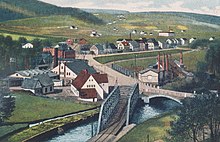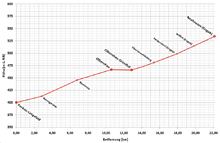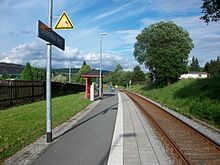Pockau-Lengefeld – Neuhausen railway line
| Pockau-Lengefeld-Neuhausen (Erzgeb) | |||||||||||||||||||||||||||||||||||||||||||||||||||||||||||||||||||||||||||||||||||||||||||||||||||||||||||||
|---|---|---|---|---|---|---|---|---|---|---|---|---|---|---|---|---|---|---|---|---|---|---|---|---|---|---|---|---|---|---|---|---|---|---|---|---|---|---|---|---|---|---|---|---|---|---|---|---|---|---|---|---|---|---|---|---|---|---|---|---|---|---|---|---|---|---|---|---|---|---|---|---|---|---|---|---|---|---|---|---|---|---|---|---|---|---|---|---|---|---|---|---|---|---|---|---|---|---|---|---|---|---|---|---|---|---|---|---|---|
|
Section of the route map of Saxony from 1902
| |||||||||||||||||||||||||||||||||||||||||||||||||||||||||||||||||||||||||||||||||||||||||||||||||||||||||||||
| Route number : | 6618; sä. PN | ||||||||||||||||||||||||||||||||||||||||||||||||||||||||||||||||||||||||||||||||||||||||||||||||||||||||||||
| Course book section (DB) : | 519 | ||||||||||||||||||||||||||||||||||||||||||||||||||||||||||||||||||||||||||||||||||||||||||||||||||||||||||||
| Route length: | 22.082 km | ||||||||||||||||||||||||||||||||||||||||||||||||||||||||||||||||||||||||||||||||||||||||||||||||||||||||||||
| Gauge : | 1435 mm ( standard gauge ) | ||||||||||||||||||||||||||||||||||||||||||||||||||||||||||||||||||||||||||||||||||||||||||||||||||||||||||||
| Route class : |
Pockau-Lengefeld-Olbernhau-Grünthal: CM3 Olbernhau-Grünthal-Neuhausen: A |
||||||||||||||||||||||||||||||||||||||||||||||||||||||||||||||||||||||||||||||||||||||||||||||||||||||||||||
| Maximum slope : | 12.5 ‰ | ||||||||||||||||||||||||||||||||||||||||||||||||||||||||||||||||||||||||||||||||||||||||||||||||||||||||||||
| Minimum radius : | 234 m | ||||||||||||||||||||||||||||||||||||||||||||||||||||||||||||||||||||||||||||||||||||||||||||||||||||||||||||
| Top speed: | 80 km / h | ||||||||||||||||||||||||||||||||||||||||||||||||||||||||||||||||||||||||||||||||||||||||||||||||||||||||||||
|
|||||||||||||||||||||||||||||||||||||||||||||||||||||||||||||||||||||||||||||||||||||||||||||||||||||||||||||
The Pockau-Lengefeld-Neuhausen railway is a branch line in Saxony . It runs in the valley of the Flöha from Pockau via Olbernhau to Neuhausen / Erzgeb. The line has belonged to the DB RegioNetz Erzgebirgsbahn since 2001 .
history
prehistory
Considerations and plans for the construction of a railway into the upper Flöhatal and to Marienberg existed as early as 1863, when the construction of the railway line from Chemnitz to Freiberg was debated. So a more southerly line than the current one was planned to connect the places in the Ore Mountains. When these plans were abandoned, it was necessary to advertise a railway through the Flöhatal via Olbernhau to Komotau . At the same time, a committee in Marienberg also made strong efforts to build a railway via Marienberg and Reitzenhain to Komotau. In 1867 two projects competed for the concession to build a railway in the Flöhatal. After the Buschtěhrad Railway and the city of Komotau decided in favor of the route via Marienberg, this route was given preference. In 1868, the Saxon state parliament approved the granting of the concession and stipulated that the line should be built with private capital.
On August 15, 1871, the Chemnitz-Komotau Railway Company was founded to build and operate the line. The railway construction company Plessner & Co. from Berlin was commissioned with the construction .
Construction of the line to Olbernhau
The groundbreaking ceremony took place on February 22, 1872. Italian workers were also used in the construction because they had a lot of experience with stone structures. Due to the economic crisis of 1873, the construction company got into economic difficulties, so that the railway company was forced to take over the construction itself. The railway construction was completed in early 1875.
After the first year of operation, the Chemnitz-Komotau railway company had to sell its line to the state because of financial losses. On December 4, 1876, the line passed to the Saxon state, the owner and operator were now the Royal Saxon State Railways .
Route extension to Neuhausen

A petition had already been submitted in 1883 to continue the route. The project developed at the time envisaged a narrow-gauge railway from Olbernhau via Sayda to Bienenmühle to connect to the Nossen – Moldau railway line . The driving force was above all the Neuhausen priest Dr. Sweet, but also the Sayda Railway Committee. In July 1890 the Saxon Ministry of Finance examined the situation in the Flöhatal and presented its own project in autumn 1891. This only provided for a standard-gauge secondary railway from Olbernhau to Neuhausen. The two chambers of the Saxon state parliament approved the project in February 1892.
The preparatory work for the construction of the line began in 1892. In October 1893, the actual construction work on the line began, which lasted over two years until autumn 1895. A total of 13,541 meters of track with 39 points were laid. The official inspection run took place on September 24, 1895, and there were no defects. On September 30, 1895, the route was finally officially opened with a pageant for invited guests.
On October 1, 1895, the scheduled train service began with four pairs of trains on the Pockau-Lengefeld-Neuhausen route.
On May 3, 1927, the branch line to Deutschneudorf ( Schweinitztalbahn ) was opened. This line was closed in 1969.
Freight traffic on the section between Olbernhau-Grünthal and Neuhausen ceased on January 1, 1994. Passenger traffic was served until June 9, 2001, after which the route was closed due to defects in the upper structure.
Redevelopment and present
The renovation of the Pockau-Lengefeld - Olbernhau section began in 2002. On January 29, 2005, the continuous train service between Chemnitz Hbf and Olbernhau was resumed. On October 29, 2005, the section between Olbernhau and Olbernhau-Grünthal was opened to traffic again. Since December 10, 2006, a uniform hourly service has been offered on weekdays between Chemnitz and Olbernhau with an intersection in Pockau-Lengefeld at the usual symmetry minute , which has only been maintained since December 2011, however, only during rush hour (Monday to Friday with a gap in the morning). Otherwise, the route is served every two hours.
The line between Olbernhau-Grünthal and Neuhausen was not repaired for the time being, as the responsible Transport Association for Central Saxony (ZVMS) no longer plans to use local rail transport. In September 2007 route maintenance measures took place. In 2010 the Olbernhau-Grünthal-Neuhausen section, which has been traffic-free since 2001, was restored to working order. On November 13, 2010, for the first time in over nine years, a special train from the Erzgebirgsbahn to Neuhausen ran.
Because of the low population density in the catchment area of the route section, the ZVMS transport authority is not expected to order local rail transport services. With the timetable change in June 2014, the capacity reduction approved by the Federal Railway Authority (reduction of the target speed from the current maximum of 40 to 10 or 20 km / h) was implemented. From February 6 to May 6, 2014, DB RegioNetz Infrastruktur GmbH ran the tender for the purpose of taking over and continuing to operate the Olbernhau-Grünthal-Neuhausen section for "interested parties who, as a railway infrastructure company, take over the section in its current state with a reduction in capacity and for want to continue to operate public transport on their own responsibility. "
The Mayor of Olbernhau, Heinz-Peter Haustein , founded the Haustein Eisenbahngesellschaft mbH in 2015 , which leased the line from the line kilometer 13,040 in August 2019. During the negotiations in 2016, Haustein received the national price of the Pro Bahn passenger association for its commitment. Since June 2020 the company has been operating as OFTB Obere Flöhatalbahn GmbH .
Route description
course
The Pockau-Lengefeld-Neuhausen railway leaves Pockau-Lengefeld station in an easterly direction. The entire length of the route now runs along the Flöha , which is crossed several times in the course of the route. The route between Blumenau and Olbernhau-Grünthal is flood-proof along the orographic left flank of the valley.
Operating points
Pockau-Lengefeld ⊙
The Pockau-Lengefeld station, which opened on February 15, 1875, is a branch station on the Reitzenhain – Flöha railway line . It is located in the corridor of the village of Pockau , the name suffix " Lengefeld " was only given because of the risk of confusion with the station of the municipality of Bockau, which is also located in the Ore Mountains . The formerly extensive facilities of the station were dismantled around 2005 with the exception of some absolutely essential tracks.
Nennigmühle ⊙
The Nennigmühle stop was established on September 1, 1877. In addition to the small, wooden reception building, the operating site had had a free pass since 1912. Until about 1945 the landlord of the nearby inn took over the ticket sales and general cargo handling as an agency.
Until 2004 the platform consisted of two parts, which were interrupted by a street. The southern part was completely renovated in the summer of 2004, the northern part demolished. The station building, which dates from 1877, was demolished in 2005 and replaced by a simple passenger shelter.
Blumenau ⊙
The stop at Blumenau has existed since the line opened. It was originally located at 5.590 km, and has been at its current location since 1877. Since 1893, the high-rise buildings consisted of a waiting hall, which in 1897 received an extension with service rooms, and a free pass. In the 1930s, a block post was set up in Blumenau, which was closed on February 23, 1970.
The waiting hall was replaced in 2000 by a simple passenger shelter.
Olbernhau West ⊙
The Olbernhau West stop has been in operation since December 9, 2007. The platform, which can be reached barrier-free via a ramp from the street “Neuer Weg”, is 80 meters long.
Olbernhau ⊙
The Olbernhau station was established in 1875 as the terminus of the line. At that time, the station facility comprised two main and five secondary tracks with 13 points. The high-rise buildings consisted of a reception building and a two-tier boiler house with a 12-meter turntable.
Over the years, the station has been expanded again and again. In the mid-1920s, the track system had grown to three main and eight side tracks with 19 single and three double crossing points. In 1940 there were also four private sidings that were connected to the station area.
A gradual reduction of the facilities began immediately after the Second World War, when track 4 was dismantled as a reparation payment. However, the most extensive dismantling of the facilities was carried out as part of the route renovation by the Erzgebirgsbahn in 2005. Today the facilities of the Olbernhau train station consist of only two main tracks with platforms and one siding. Traffic systems for freight traffic no longer exist. The massive boiler house from 1875, which had been unused for a long time and which was last used to house the station locomotive and the railway maintenance office, was demolished in 2007.
Olbernhau-Grünthal ⊙
The Olbernhau-Grünthal train station was first opened as the Grünthal stop on October 1, 1895 and upgraded to a train station in 1905. The station building is a brick-built type building, like the one that was erected at other train stations in Saxony at the same time.
In its greatest expansion from 1914, the station had three main and three side tracks with 14 single points and a double crossing point. The first reduction of the facilities took place in 1943, when a track connection with two switches was dismantled in favor of projects that were important to the war effort. In 2005 the Erzgebirgsbahn dismantled all side tracks except for the continuous main track. A new platform was built in a new location on the side facing away from the station building. In operational terms, Olbernhau-Grünthal has been a train station again since 2007.
Name history:
- until 1900: Grünthal
- until 1928: Kupferhammer-Grünthal
- until 1938: Kupferhammer Grünthal
- since 1938: Olbernhau-Grünthal
From 1927 and 1969, Olbernhau-Grünthal was the starting point for the Schweinitztal Railway to Deutschneudorf.
Junction Neuschönberg ⊙
At the Neuschönberg junction, the Schweinitztalbahn branched off to Deutschneudorf from the Pockau-Lengefeld-Neuhausen line. The striking, massive signal box building was only occupied when train journeys to and from Deutschneudorf required it. For the rest of the time, the operating point on the Olbernhau – Neuhausen route was switched through, which means that the main signals on this route always showed "Clear the way." The high-rise buildings of the operating site are still there today and are reused by a local allotment gardener association.
Oberneuschönberg ⊙
Today's Oberneuschönberg stop was originally intended as an access point for the parts of the Schweinitztal valley, which at that time still had no railroad. For freight traffic, the operating site originally had a loading track integrated on both sides, which had already been partially dismantled in 1940. It was mainly used by forestry for loading raw wood. In March 1966, the remaining points and the loading track were expanded and the previous stop was downgraded to a stop.
The high-rise buildings originally consisted of a waiting hall and free access. The extension for the luggage and waiting room consisted of an old freight car body that was integrated into the building. After the building was demolished in the mid-1990s, a small wooden hut was set up as a passenger shelter.
Name history:
- until 1903: Schweinitzthal
- until 1939: Schweinitztal
- since 1939: Oberneuschönberg
Since the line was closed between Olbernhau-Grünthal and Neuhausen in 2001, the stop has been without regular passenger traffic.
Heidersdorf (Erzgeb) ⊙
The Heidersdorf (Erzgeb) stop was opened as the Niederseiffenbach stop on October 1, 1895 . Like Oberneuschönberg, the operating site had a loading platform integrated on both sides. In addition, the connecting railway of the woodworking company Gebr. Einhorn branched off from the main track since 1912 . The high-rise buildings originally consisted of the reception building with service and waiting room, a goods shed and a free pass. The station was given its current name Heidersdorf (Erzgeb) on May 15, 1939.
Between 1963 and 1966 the DR removed the loading siding. The connecting railway was operated until after 1990. It was finally closed with the termination of the connecting railway contract on December 31, 1993. Since then, Heidersdorf (Erzgeb) has only been a stopping point.
Since the line was closed between Olbernhau-Grünthal and Neuhausen in 2001, the stop has been without regular passenger traffic. The unused waiting hall was demolished around 2005 without replacement.
Seiffen (Erzgeb) ⊙
The Seiffen (Erzgeb) stop was opened on October 1, 1895 on Dittersbacher Flur as the Seiffen-Dittersbach stop , and since 1951 it has had its current name after the remote but nationally known spa town of Seiffen / Erzgeb. In Seiffen, too, there was originally a loading track integrated on both sides, which was mainly used by forestry. In contrast to the other intermediate stations, the operating center has a massive, now unused reception building.
Since the line was closed between Olbernhau-Grünthal and Neuhausen in 2001, the stop has been without regular passenger traffic.
Neuhausen (Erzgeb) ⊙
The station Neuhausen (Erzgeb) is the terminus of the route and had the opening on October 1, 1895, two main and five sidings. The brick-clad station building is a type of construction like the one that was used by other Saxon railways at the time. From 1898 the station had reached its greatest extent, which now comprised eight tracks with eleven single and two double crossing points. In addition to the station building, the high-rise buildings also included a goods shed and a two-tier boiler house.
In the station area was the connecting line of the chair and furniture factory Carl Helbig, which presumably existed since the construction of the line. Most recently, the company operated as VEB United Sitzmöbelindustrie Neuhausen. On December 31, 1993 the connecting railway contract was terminated and the tracks were dismantled in 1994. The connecting line for the construction site of the Rauschenbach dam , which existed from 1961 to 1965, was more important. For this purpose, the continuous main track 1 was extended over the Flöha, where a double-track unloading point for the building materials was set up.
When all traffic on the Mulda – Sayda narrow-gauge railway was discontinued in 1966, a large part of the wagonload there was relocated to Neuhausen station.
Name history:
- until 1911: Neuhausen i Saxony
- until 1933: Neuhausen (Sa)
- until 1938: Neuhausen (Sachs)
- since 1938: Neuhausen (Erzgeb)
Since the line was closed between Olbernhau-Grünthal and Neuhausen in 2001, the station has been without regular traffic.
Vehicle use
The Chemnitz-Komotauer Eisenbahn procured two tank locomotives for their branch line, which were later classified as class VII T by the state railways . On the Chemnitz-Komotau Railway they had the numbers 9 and 14 .
From the 1970s to 1994, passenger trains were mostly made up of four-axle reko cars and diesel locomotives of the DR series 110 and 112. From 1994 to May 1998, some railcars of the DB class 772 were used, and after the timetable change in May 1998, only push-pull trains from Halberstadt center entry cars and the DB class 219 were used.
The Erzgebirgsbahn initially used the DB class 628 railcars . Today only railcars of the DB class 642 "Desiro" are used.
literature
- Günter Baldauf: The Flöhatalbahn . Altis-Verlag, Friedrichsthal 2001, ISBN 3-910195-30-X .
- Reiner Bretfeld: 100 years of the Flöhatalbahn . DMV AG 3/42, Marienberg 1975.
- Dittrich Marz: 130 years of the Flöhatalbahn. Lengefelder Nachrichten 2005–2006, a series of 12 parts
- Stephan Häupel: The railway in the Flöhatal and its regular- gauge branch lines . 1st edition. Bildverlag Böttger, Witzschdorf 2008, ISBN 978-3-937496-08-5 .
Web links
Individual evidence
- ↑ Model railroader. Magazine for prototype and model. Volume 60, No. 1, January 2011, p. 10.
- ↑ a b DB Netz AG - Transfer of Railway Infrastructure, Section 6618 Olbernhau-Grünthal - Neuhausen ( Memento of March 28, 2014 in the Internet Archive ), accessed on March 28, 2014
- ↑ Free press : DB Regionetz wants to sell six routes on the Internet , accessed on March 28, 2014
- ↑ Suspended? Olbernhau does not want to give up the railway line. Mitteldeutscher Rundfunk , August 20, 2019, accessed on November 2, 2019 .
- ↑ The price for the effort to maintain the Erzgebirgsbahn - WochenENDspiegel . In: WochenENDspiegel . March 30, 2016 ( wochenendspiegel.de [accessed December 7, 2017]).
- ↑ A look at the commercial register In: Bahn-Report . Edited by the Association of Rail Transport Associations. V., Rohr, No. 5./2020, p. 25. ISSN 0178-4528
- ↑ The wooden waiting hall at the Nennigmühle stop at www.sachsenschiene.net
- ↑ The stop at Blumenau at www.sachsenschiene.net
- ↑ The waiting hall in Heidersdorf (Erzgeb) on www.sachsenschiene.net














